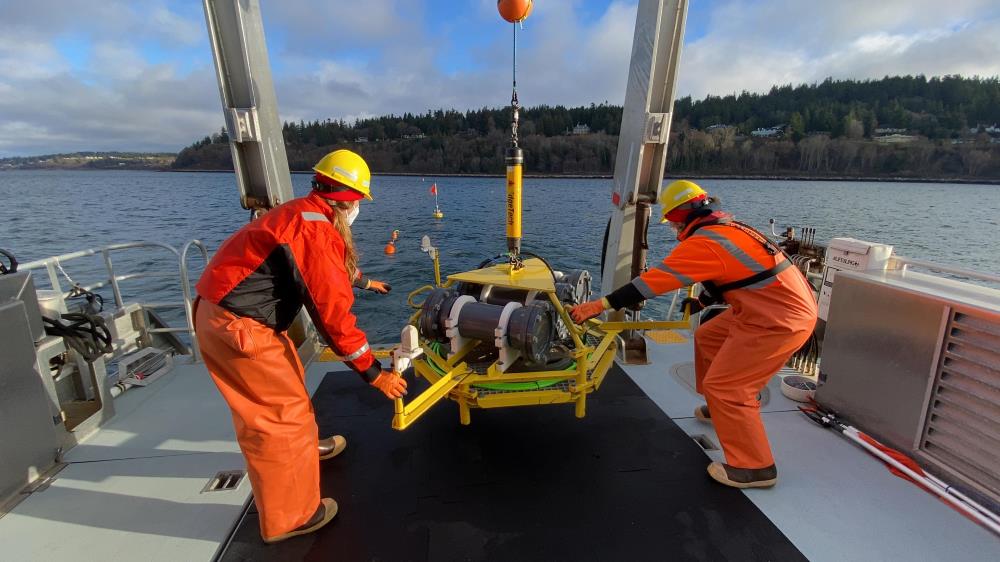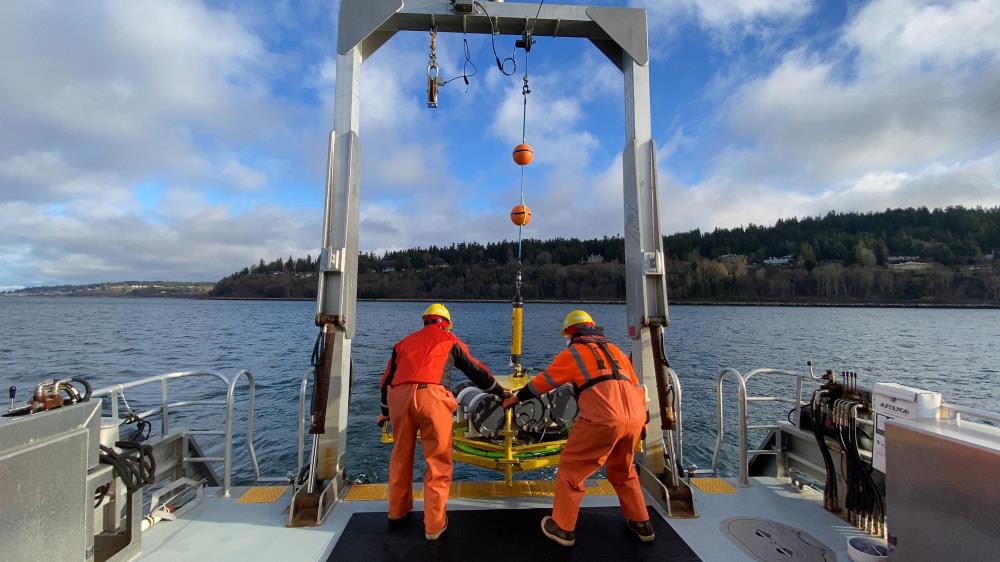Scientists aboard King County’s research vessel deploy buoy in Puget Sound to measure underwater noise, a risk to southern resident orcas
Summary
King County’s research vessel and crew helped researchers from SMRU Consulting deploy a buoy that will measure underwater noise from commercial and recreational vessels. The study will help increase the frequency and quality of reports of orca sightings provided to pilots of large vessels so they can voluntarily slow down or change course.
Story
Marine mammal scientists aboard the SoundGuardian, King County’s research vessel, deployed a buoy into Puget Sound that will measure the underwater noise from commercial and recreational vessels that pose multiple risks to southern resident orcas.
The pro bono study by SMRU Consulting – which conducts marine mammal research worldwide – will help increase the frequency and quality of reports of orca sightings provided to pilots of large vessels so they can voluntarily slow down or change course, reducing the amount of underway noise and preventing collisions.
Researchers chose to deploy the buoy during winter when orcas are regularly found in Puget Sound pursuing chinook and chum salmon. Orcas rely on their use of sound to hunt, communicate, navigate, and avoid danger which can be limited by noise generated from maritime activities. Data on the presence of vessels and orcas will be transmitted to scientists in real time as well as recorded for future analysis.
“Our state-of-the-art research vessel is a valuable asset helping some of the world’s leading marine biologists work to protect southern resident orcas,” said King County Executive Dow Constantine. “The scientific research they produce will contribute to our collective mission to not only track the health of Puget Sound, but also ensure the survival of its marine life.”
SMRU Consulting, established by the University of St. Andrews in Scotland, has conducted similar research worldwide, including for the ECHO Program in British Columbia. The buoy technology was originally developed by SMRU Consulting to mitigate the effects of offshore wind construction noise on endangered North Atlantic right whales.
“We’re grateful to King County for making the SoundGuardian available for this effort," said Jason Wood, Managing Director at SMRU Consulting and lead scientist on this project. “We hope the data generated by this pilot study will help inform long-standing recovery efforts by organizations such as NOAA, Quiet Sound, Orca Network, OrcaSound, the Whale Museum, OceanWise and others.”
The buoy consists of several underwater microphones that passively listen for calling orcas and measure noise levels. A computer onboard processes the audio data in real time, stores results, and sends key orca detections via a cell connection on the surface.
The research supports the goals of the Quiet Sound Program, which was created by the Southern Resident Orca Task Force convened by Gov. Jay Inslee in 2018. One of the task force recommendations is to reduce the noise from ships and ferries near southern resident orcas.
King County’s Water and Land Resources Division – one of four divisions within the Department of Natural Resources and Parks – provided the scientists with the research vessel and crew needed to deploy the buoy offshore of Spring Beach, between Seattle and Edmonds. The crew will take the scientists back out in about three months to retrieve the buoy, with an additional check-in and data download at the midway point.
“I’m glad I could help connect these researchers and scientists to create a public-private partnership,” said Fred Felleman, working in his personal capacity as a longtime killer whale conservation biologist who has been serving on the Seattle Port Commission since 2016. “It’s only through collaborations such as this, in support other programs around the Sound, that we can hope to recover our iconic orca.”
Images
Relevant links
- VIDEO: Recording of the buoy deployment
- VIDEO: News media is invited to download b-roll footage
- Meet the SoundGuardian, King County's working research vessel
- SMRU Consulting
- Partners: NOAA, Orca Network, OrcaSound, The Whale Museum, OceanWise, Quiet Sound
- TRACKS: An interactive map showing the progress we're making to protect and restore King County's natural environment
Quotes
Our state-of-the-art research vessel is a valuable asset helping some of the world’s leading marine biologists work to protect southern resident orcas. The scientific research they produce will contribute to our collective mission to not only track the health of Puget Sound, but also ensure the survival of its marine life.
We’re grateful to King County for making the SoundGuardian available for this effort. We hope the data generated by this pilot study will help inform long-standing recovery efforts by organizations such as NOAA, Quiet Sound, Orca Network, OrcaSound, the Whale Museum, OceanWise and others.
I’m glad I could help connect these researchers and scientists to create a public-private partnership. It's only through collaborations such as this, in support other programs around the Sound, that we can hope to recover our iconic orca.
For more information, contact:
Chad Lewis, Department of Natural Resources and Parks, 206-263-1250

 Translate
Translate

